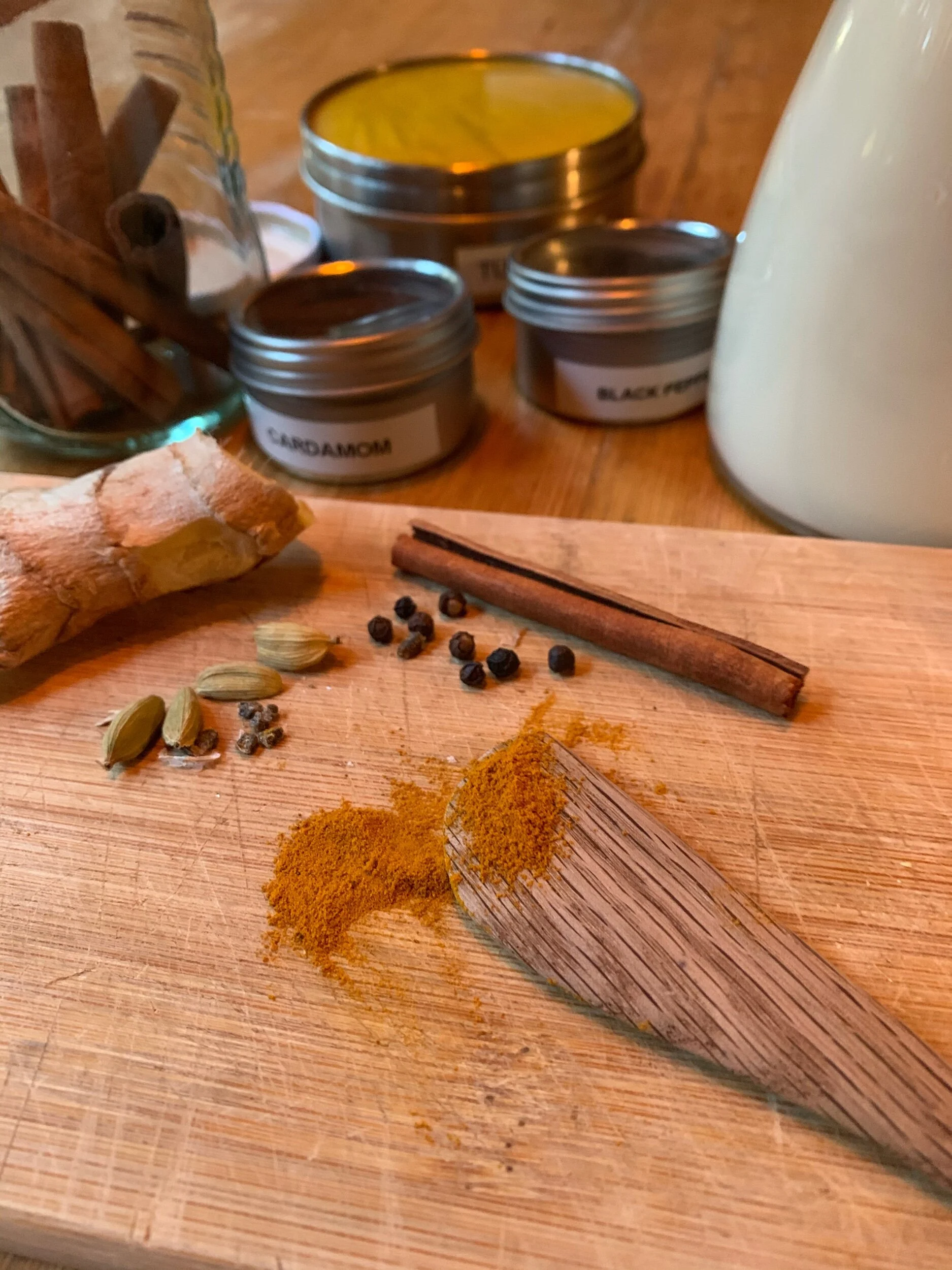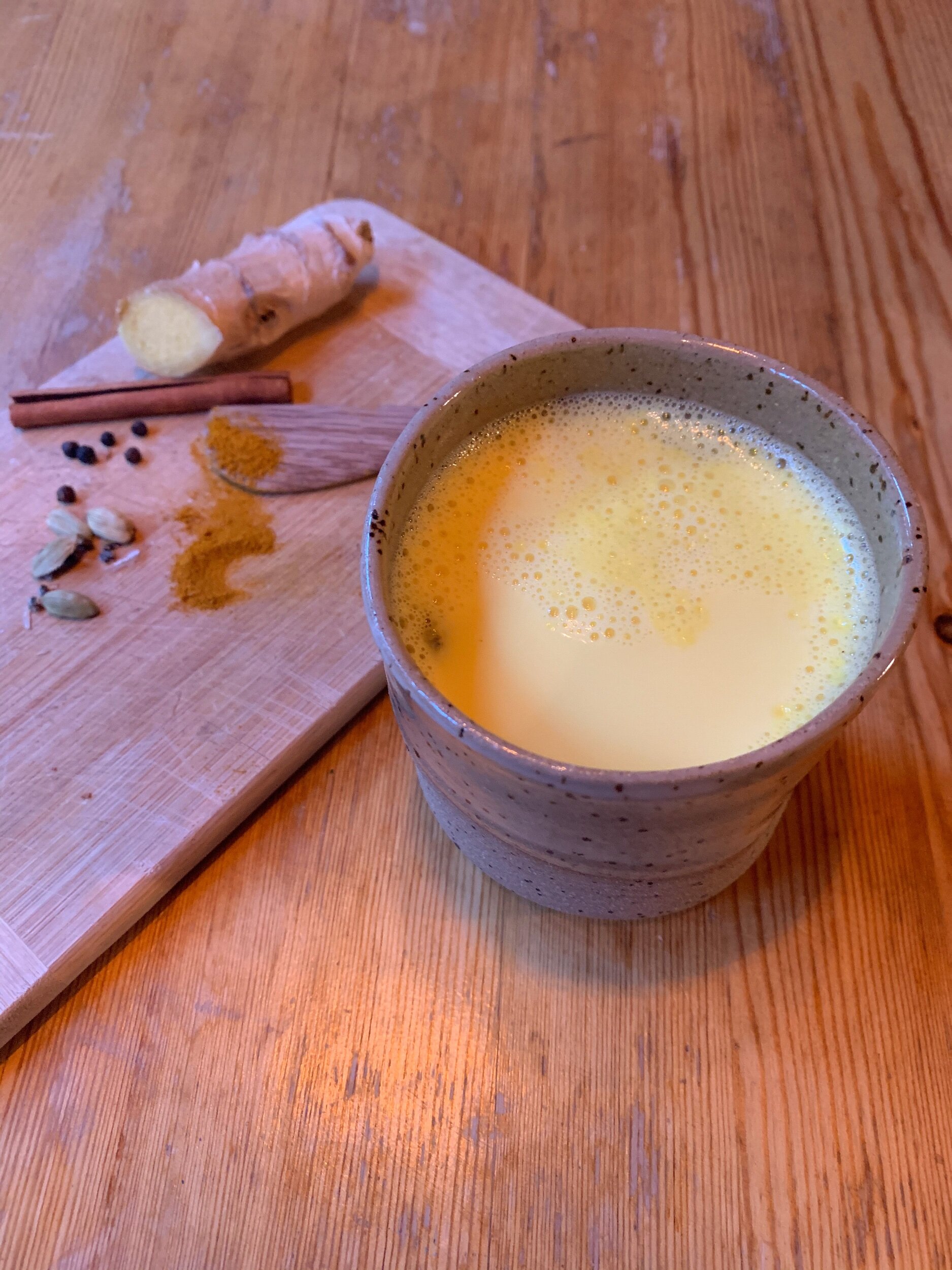Turmeric: Wisdom and Modern Research
WELCOME TO MY BLOG! I’M EVANGELINE & A MOM. ALSO, AN RMT, and AYURVEDA-YOGA COUNSELLOR. I STARTED MY BLOG DURING COVID TO STAY CONNECTED TO MY CLIENTS AND SHARE MY LOVE OF COOKING HEALTHY, AYURVEDIC MEALS.
AYURVEDIC COOKING TAKES A BALANCED, HEALING APPROACH FOR YOUR DAILY COOKING NEEDS. YOU WILL FIND SIMPLE, EASY TO MAKE NOURISHING MEALS I HAVE MADE FOR MY FAMILY, WITH A DOSE OF AYURVEDA & YOGA WISDOM.
I had first heard of turmeric and its medicinal properties from my Ayurvedic teacher, Vaidya Mishra. He said that in India every household uses turmeric. It is commonly used in everyday cooking, or added to warm milk, and combined with other spices such as fennel, coriander, cumin, cardamom, cloves.
My teacher wondered why Alzheimers in North America is common, whereas in India it wasn’t the case. He attributed this primarily to turmeric in the Indian diet. As it turns out he was correct about this as some of the research is showing. *In addition, he emphasized the importance of cooking turmeric in ghee or olive oil with other spices like fennel and coriander for their cooling qualities, thus helping take the edge off its heating and drying effect, plus the oil delivers the medicinal properties to the cells. He also emphasized to not consume raw, or it will “overheat the liver.” The liver is the seat of digestion and already a “hot” organ because it has “five flames” responsible for digesting the five elements of nature: space, air, fire, water, earth. He called turmeric, “a friend to the liver” because it detoxifies it. Though turmeric’s active ingredient is curcumin, it is best to have turmeric the spice, not just the curcumin, as it is said in the ancient Ayurvedic texts that if you take “part from the whole, it will make the body sick”.
The hundreds of research papers on turmeric to date confirm the reasons why turmeric has been used for thousands of years in India and in other Asian countries as a powerful healing spice mainly due to its antioxidant, anti-inflammatory and anti-cancer properties.
Turmeric’s Benefits:
01. Preventative measure for Alzheimer’s, Parkinson’s, multiple sclerosis, epilepsy, cerebral injury, cardiovascular disease, cancer, allergy, asthma, bronchitis, colitis, arthritis, renal ischemia, psoriasis, diabetes, obesity, depression, fatigue, and acquired immune deficiency syndrome (AIDS)
02. Metabolic Syndrome
03. Arthritis
04. Anxiety
05. Hyperlipidemia
Ayurveda recognizes spices, such as turmeric, as being more effective as a preventive measure, averting imbalances from developing into a disease.
Research shows relatively low dose of turmeric can provide health benefits to people who do not have diagnosed health conditions. Active people can also benefit with helping reduce muscle soreness, helping recovery and performance.
Research recently proved that ingesting curcumin, the isolated active ingredient of turmeric, does not lead to turmeric’s associated health benefits because of its poor absorption, rapid metabolism and rapid elimination. To me this echoes- take wisdom advice by cooking turmeric powder with ghee or olive oil, as the fat acts as the vehicle to carry the active ingredients to target areas. Research does show adding black pepper when combined with curcumin increases bioavailability by 2,000%. Though it has been established curcumin is safe as a supplement (Allowable Daily Intake of 0–3 mg/kg body weight) there have been negative side effects reported including diarrhea, headache, rash, yellow stool and nausea.
With the powerful benefits of turmeric as an antioxidant, anti-inflammatory and anti-cancer agent, it is no wonder why the quick and easy curcumin supplement can be appealing. I, however, will take the wisdom and the science together and take turmeric to the kitchen and cook with it.
* Turmeric is bitter, pungent, heating and drying. Caution when using if you have a liver disease or liver disorder and when you are feeling high emotional stress.
How we use turmeric at home
01. Spice Mix Recipe
6 tsps fennel seeds
6 tsps coriander seeds
1 tsp cumin seeds
1 tsp turmeric powder
Grind fennel, coriander and cumin in a spice grinder, then add in turmeric powder and pulse grind to combine all together.
Store in a jar with a lid in a cool place. Keeps for 4-6 weeks.
You can also dry toast the fennel, coriander and cumin seeds on a fry pan in low heat until aroma is released before grinding. Sprinkle onto food when you are on the go and travelling.
A spice mix I learned from my Ayurvedic teacher Vaidya Mishra, this mix aids in digestion, assimilation and absorption of nutrients. I also add other spices to this mix, depending on what my family would like to eat or if anyone needs extra attention with their tummy. If you’re new to spices just start with a pinch or two in your meals. The book The Yoga of Herbs is an excellent reference guide. Also my Ayurveda teacher has made available to us a line of high quality Ayurvedic herbal formulations and products to care for our health, including a line of spice mixes on Chandika.
Try to get non-irradiated and organic, and seed form as they remain fresh longer than ground spices.
Fennel - supports digestion; cooling quality
Coriander - ushers heavy metals and toxins to kidneys for elimination; cooling quality
Turmeric- cleans the liver; anti-inflammatory, antioxidant, anti-viral, anti-bacterial
Cumin - helps in absorption of nutrients
02. Golden Milk
1 cup whole milk or any plant based milk
1-2 cardamom pods
1 small cinnamon stick
1- 2 pinches turmeric
Instructions
Bring milk to a boil.
Add spices and let boil for a few more minutes, stirring occasionally.
Let cool. Sip slowly.
Enjoy!
Turmeric gives the skin a nice glow. It acts on the pitta subdosha, bhrajaka, seated in the skin. In the fall and winter season, add a slice of ginger root, giving it another anti-inflammatory boost. You can also add crushed black peppercorns to boost turmeric’s action.
Cardamom - helps digest protein in milk
Cinnamon - helps with sugar metabolism
Black peppercorns - helps open up the channels
Ginger root - burns ama; use with caution when pitta aggravated and during summer time; dry ginger or sunthi has less heat than fresh ginger
03. For Colds and Flus
Turmeric attacks viral and bacterial infections upon contact.
1 Tbsp ghee
1 tsp turmeric
Instructions
On low heat melt ghee in a pan.
Add turmeric stirring constantly for a minute. Discard if turmeric gets burnt and start over.
Pour mixture over your food at lunch and dinner.
REFERENCES
https://youtu.be/cafoiHQiwPw
https://www.ncbi.nlm.nih.gov/pmc/articles/PMC5664031/
http://drmteitelbaum.com
“Healing the Thyroid with Ayurveda”, Marianne Teitelbaum
Vaidya R. K. Mishra- Notes from Shaka Vansiya Ayurveda Courses, Practicum, Conferences and Lectures 2003-2015


